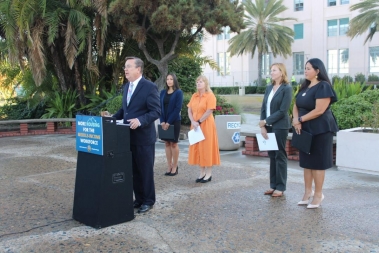 Supervisors Joel Anderson and Vice Chair Nora Vargas brought forward Tuesday’s board action
Supervisors Joel Anderson and Vice Chair Nora Vargas brought forward Tuesday’s board action
Photo: in anticipation of Tuesday’s vote, Supervisor Anderson (left, at podium) and Vice Chair Vargas (right) hosted a press conference along with Deborah Norwood Ruane (center-right), founder of the Middlemarch Fund, Lori Holt Pfeiler (center), CEO of Building Industry Association, and Angeli Calinog Hoyos (center-left), Public Affairs Manager at the San Diego Regional Chamber of Commerce.
October 1, 2022 (San Diego) - At the Tuesday, September 27th meeting, the San Diego County Board of Supervisors unanimously approved a board letter, put forth by County Supervisor Joel Anderson (District 2) and Vice Chair Nora Vargas (District 1), that will direct County staff to develop a pilot workforce housing program.
Tuesday's board action directed the County to create a revolving fund that will create more housing units for our region’s workforce whose incomes are in the 80% - 120% Area Median Income (AMI) category.
As the cost of living and housing prices continue to rapidly increase in the San Diego region, many middle-class individuals and families are unable to afford adequate housing. This spring, the median price for a single-family house in San Diego County reached $950,000, an increase of 28.5% over the previous year’s price.
While the Board has supported several programs to help the County’s low-income residents such as the Innovative Housing Trust Fund, No Place Like Home, Project Homekey and Community Development Block Grants, there are currently no funding sources available to expand housing opportunities for vulnerable middle-class households whose state tax credits are cut off at 80% AMI.
“Our region’s workforce including our nurses, teachers, law enforcement officers, construction workers, engineers, and store managers deserve to live close to where they work,” said Supervisor Joel Anderson. “This is an important step in addressing the housing crisis and making the dream of home ownership a reality for all San Diego County residents.”
“As a County, it is our responsibility to expand housing opportunities for all, and this policy will help bring housing solutions for our middle-income households and workforce, who are the backbone of our economy,” said Vice Chair Nora Vargas, San Diego County Board of Supervisors. “Our region’s workforce, especially people of color, have been living with limited opportunities for housing including homeownership, for far too long. We know that homeownership is the single most powerful tool for building generational wealth, but our residents are facing record-high home prices and escalating mortgage costs. Today, we reaffirm our commitment to finding equitable housing solutions that target the lack of middle-class housing affordability to ensure the American Dream to buy a house is attainable.”
Additionally, today’s board action has directed County staff to investigate the potential expansion of the County’s first-time home buyer program to include individuals in the 80% - 120% AMI range, who are not currently eligible to participate.
Vice Chair Vargas and Supervisor Anderson also recommended the formation of a Middle-Income Housing Workgroup to provide input on current production barriers, ways to increase workforce housing production, and other ideas to increase workforce housing opportunities.
San Diego’s housing has resulted in a significant gap in housing for our workforce, including our teachers, healthcare workers, public safety officers, and those employed in construction and other trades. This lack of housing production has also prevented many of those living in affordable housing units from transitioning to the next level of home ownership, causing waitlists for affordable units to grow rapidly.
According to a recent Pew Research Center analysis, about half of U.S. families (52%) are considered middle-class households. However, the focus of government intervention has been to support affordable housing production for low to extremely low-income individuals.
Upon the program’s approval, the Chief Administrative Officer will report back to the board in 180 days with specific options and recommendations on how the County can move forward with developing the pilot program and securing funding sources.
 Photo, right: Vice Chair Nora Vargas (at podium) speaks at the press conference on Tuesday morning.
Photo, right: Vice Chair Nora Vargas (at podium) speaks at the press conference on Tuesday morning.
Industry experts spoke in support of Anderson and Vargas’ workforce housing item at this morning’s press conference and during the board meeting.
Middlemarch Fund founder Deborah Norwood Ruane shared, “San Diego needs housing for all, including and especially homeownership opportunities. To have the County lead in this effort is bold and is to be applauded.”
Lori Holt Pfeiler, CEO of Building Industry Association, expressed, “When we think about the ‘missing middle,’ we are talking about the backbone of our communities. We need housing affordable to middle-income families; this proposal will do just that.”
Angeli Calinog Hoyos, Public Affairs Manager for the San Diego Regional Chamber of Commerce, stated, “The Chamber can attest that this process is a great opportunity to… pave a better way for our region’s current and future workforce.”








Comments
That's really funny
A HUGE part of the problem is the excessive fee structure the County has in place to build a home. Second is the DPLU and inspectors who would not know what a nail was if you showed the, THE BOS is the problem not the solution.
. . . .look for a study in 6 months
Take a look at the Butterfield Community
(1) Just do the math, then (2) Just do it.